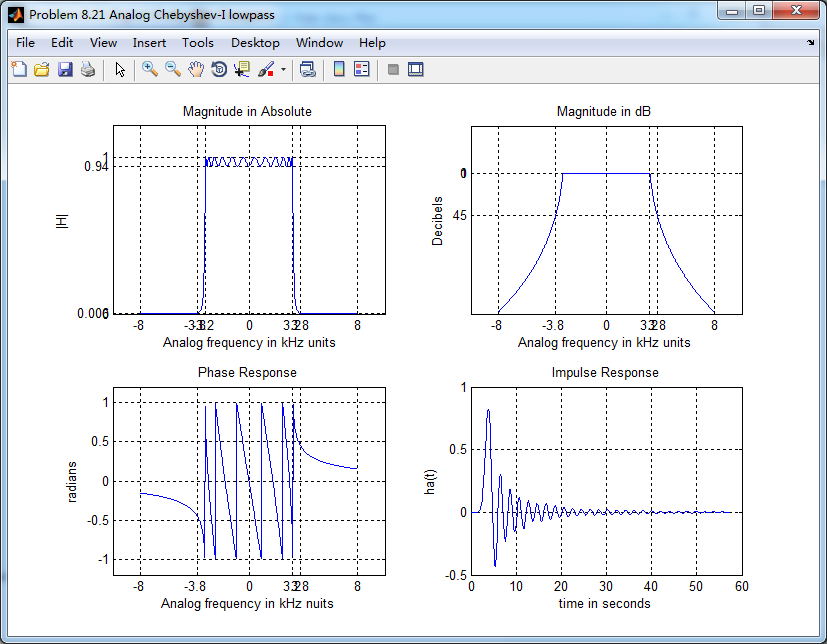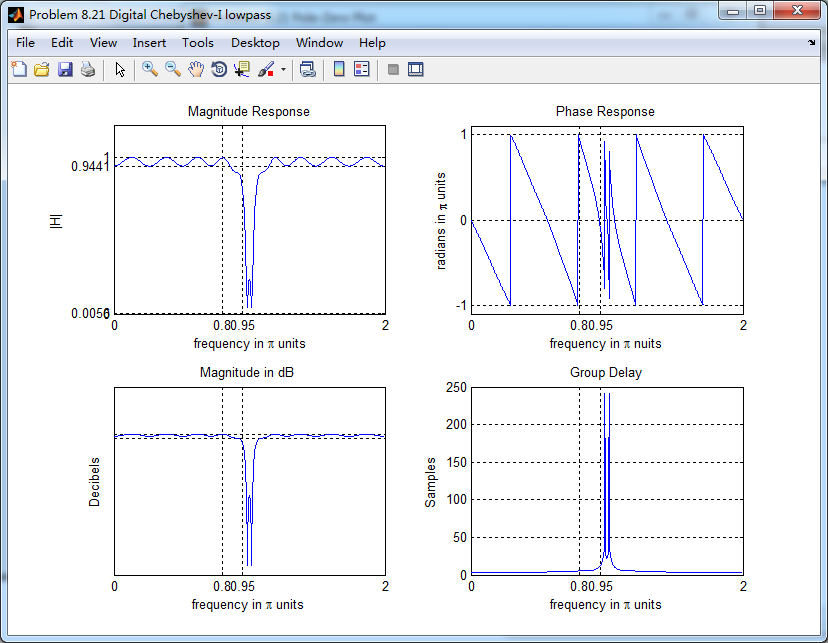《DSP using MATLAB》Problem 8.21

代码:
%% ------------------------------------------------------------------------
%% Output Info about this m-file
fprintf('\n***********************************************************\n');
fprintf(' <DSP using MATLAB> Problem 8.21 \n\n'); banner();
%% ------------------------------------------------------------------------ Fp = 3.2; % analog passband freq in kHz
Fs = 3.8; % analog stopband freq in kHz
fs = 8; % sampling rate in kHz % -------------------------------
% ω = ΩT = 2πF/fs
% Digital Filter Specifications:
% -------------------------------
%wp = 2*pi*Fp/fs; % digital passband freq in rad/sec
wp = Fp;
%ws = 2*pi*Fs/fs; % digital stopband freq in rad/sec
ws = Fs;
Rp = 0.5; % passband ripple in dB
As = 45; % stopband attenuation in dB Ripple = 10 ^ (-Rp/20) % passband ripple in absolute
Attn = 10 ^ (-As/20) % stopband attenuation in absolute % Analog prototype specifications: Inverse Mapping for frequencies
T = 1; % set T = 1
OmegaP = wp/T; % prototype passband freq
OmegaS = ws/T; % prototype stopband freq % Analog Chebyshev-1 Prototype Filter Calculation:
[cs, ds] = afd_chb1(OmegaP, OmegaS, Rp, As); % Calculation of second-order sections:
fprintf('\n***** Cascade-form in s-plane: START *****\n');
[CS, BS, AS] = sdir2cas(cs, ds)
fprintf('\n***** Cascade-form in s-plane: END *****\n'); % Calculation of Frequency Response:
[db_s, mag_s, pha_s, ww_s] = freqs_m(cs, ds, 8); % Calculation of Impulse Response:
[ha, x, t] = impulse(cs, ds); % Impulse Invariance Transformation:
[b, a] = imp_invr(cs, ds, T); [C, B, A] = dir2par(b, a) % Calculation of Frequency Response:
[db, mag, pha, grd, ww] = freqz_m(b, a); %% -----------------------------------------------------------------
%% Plot
%% -----------------------------------------------------------------
figure('NumberTitle', 'off', 'Name', 'Problem 8.21 Analog Chebyshev-I lowpass')
set(gcf,'Color','white');
M = 1.0; % Omega max subplot(2,2,1); plot(ww_s, mag_s/T); grid on; %axis([-10, 10, 0, 1.2]);
xlabel(' Analog frequency in kHz units'); ylabel('|H|'); title('Magnitude in Absolute');
set(gca, 'XTickMode', 'manual', 'XTick', [-8, -3.8, -3.2, 0, 3.2, 3.8, 8]);
set(gca, 'YTickMode', 'manual', 'YTick', [0, 0.006, 0.94, 1]); subplot(2,2,2); plot(ww_s, db_s); grid on; %axis([0, M, -50, 10]);
xlabel('Analog frequency in kHz units'); ylabel('Decibels'); title('Magnitude in dB ');
set(gca, 'XTickMode', 'manual', 'XTick', [-8, -3.8, 0, 3.2, 3.8, 8]);
set(gca, 'YTickMode', 'manual', 'YTick', [-45, -1, 0]);
set(gca,'YTickLabelMode','manual','YTickLabel',['45';' 1';' 0']); subplot(2,2,3); plot(ww_s, pha_s/pi); grid on; axis([-10, 10, -1.2, 1.2]);
xlabel('Analog frequency in kHz nuits'); ylabel('radians'); title('Phase Response');
set(gca, 'XTickMode', 'manual', 'XTick', [-8, -3.8, 0, 3.2, 3.8, 8]);
set(gca, 'YTickMode', 'manual', 'YTick', [-1:0.5:1]); subplot(2,2,4); plot(t, ha); grid on; %axis([0, 30, -0.05, 0.25]);
xlabel('time in seconds'); ylabel('ha(t)'); title('Impulse Response'); figure('NumberTitle', 'off', 'Name', 'Problem 8.21 Digital Chebyshev-I lowpass')
set(gcf,'Color','white');
M = 2; % Omega max subplot(2,2,1); plot(ww/pi, mag); axis([0, M, 0, 1.2]); grid on;
xlabel(' frequency in \pi units'); ylabel('|H|'); title('Magnitude Response');
set(gca, 'XTickMode', 'manual', 'XTick', [0, 0.8, 0.95, M]);
set(gca, 'YTickMode', 'manual', 'YTick', [0, 0.0056, 0.9441, 1]); subplot(2,2,2); plot(ww/pi, pha/pi); axis([0, M, -1.1, 1.1]); grid on;
xlabel('frequency in \pi nuits'); ylabel('radians in \pi units'); title('Phase Response');
set(gca, 'XTickMode', 'manual', 'XTick', [0, 0.8, 0.95, M]);
set(gca, 'YTickMode', 'manual', 'YTick', [-1:1:1]); subplot(2,2,3); plot(ww/pi, db); axis([0, M, -30, 10]); grid on;
xlabel('frequency in \pi units'); ylabel('Decibels'); title('Magnitude in dB ');
set(gca, 'XTickMode', 'manual', 'XTick', [0, 0.8, 0.95, M]);
set(gca, 'YTickMode', 'manual', 'YTick', [-60, -45, -1, 0]);
set(gca,'YTickLabelMode','manual','YTickLabel',['60';'45';' 1';' 0']); subplot(2,2,4); plot(ww/pi, grd); grid on; %axis([0, M, 0, 35]);
xlabel('frequency in \pi units'); ylabel('Samples'); title('Group Delay');
set(gca, 'XTickMode', 'manual', 'XTick', [0, 0.8, 0.95, M]);
%set(gca, 'YTickMode', 'manual', 'YTick', [0:5:35]); figure('NumberTitle', 'off', 'Name', 'Problem 8.21 Pole-Zero Plot')
set(gcf,'Color','white');
zplane(b,a);
title(sprintf('Pole-Zero Plot'));
%pzplotz(b,a); % ----------------------------------------------
% Calculation of Impulse Response
% ----------------------------------------------
figure('NumberTitle', 'off', 'Name', 'Problem 8.21 Imp & Freq Response')
set(gcf,'Color','white');
t = [0:0.01:60]; subplot(2,1,1); impulse(cs,ds,t); grid on; % Impulse response of the analog filter
axis([0,60,-0.5,1.0]);hold on n = [0:1:60/T]; hn = filter(b,a,impseq(0,0,60/T)); % Impulse response of the digital filter
stem(n*T,hn); xlabel('time in sec'); title (sprintf('Impulse Responses T=%2d',T));
hold off % Calculation of Frequency Response:
[dbs, mags, phas, wws] = freqs_m(cs, ds, 2*pi/T); % Analog frequency s-domain [dbz, magz, phaz, grdz, wwz] = freqz_m(b, a); % Digital z-domain %% -----------------------------------------------------------------
%% Plot
%% ----------------------------------------------------------------- subplot(2,1,2); plot(wws/(2*pi),mags/T,'b+', wwz/(2*pi*T),magz,'r'); grid on; xlabel('frequency in Hz'); title('Magnitude Responses'); ylabel('Magnitude'); text(-0.8,0.15,'Analog filter'); text(0.6,1.05,'Digital filter');
运行结果:
通带、阻带指标

模拟Chebyshev-1型低通系统函数,串联形式系数

脉冲响应不变法,转换成数字低通,系统函数直接形式系数

模拟Chebyshev-1型低通,幅度谱、相位谱和脉冲响应

数字Chebyshev-1型低通,幅度谱、相位谱和群延迟


《DSP using MATLAB》Problem 8.21的更多相关文章
- 《DSP using MATLAB》Problem 6.21
代码: %% ++++++++++++++++++++++++++++++++++++++++++++++++++++++++++++++++++++++++++++++++ %% Output In ...
- 《DSP using MATLAB》Problem 5.21
证明: 代码: %% ++++++++++++++++++++++++++++++++++++++++++++++++++++++++++++++++++++++++++++++++++++++++ ...
- 《DSP using MATLAB》Problem 4.21
快到龙抬头,居然下雪了,天空飘起了雪花,温度下降了近20°. 代码: %% -------------------------------------------------------------- ...
- 《DSP using MATLAB》Problem 3.21
模拟信号经过不同的采样率进行采样后,得到不同的数字角频率,如下: 三种Fs,采样后的信号的谱 重建模拟信号,这里只显示由第1种Fs=0.01采样后序列进行重建,采用zoh.foh和spline三种方法 ...
- 《DSP using MATLAB》Problem 7.27
代码: %% ++++++++++++++++++++++++++++++++++++++++++++++++++++++++++++++++++++++++++++++++ %% Output In ...
- 《DSP using MATLAB》Problem 7.26
注意:高通的线性相位FIR滤波器,不能是第2类,所以其长度必须为奇数.这里取M=31,过渡带里采样值抄书上的. 代码: %% +++++++++++++++++++++++++++++++++++++ ...
- 《DSP using MATLAB》Problem 7.24
又到清明时节,…… 注意:带阻滤波器不能用第2类线性相位滤波器实现,我们采用第1类,长度为基数,选M=61 代码: %% +++++++++++++++++++++++++++++++++++++++ ...
- 《DSP using MATLAB》Problem 7.23
%% ++++++++++++++++++++++++++++++++++++++++++++++++++++++++++++++++++++++++++++++++ %% Output Info a ...
- 《DSP using MATLAB》Problem 7.16
使用一种固定窗函数法设计带通滤波器. 代码: %% ++++++++++++++++++++++++++++++++++++++++++++++++++++++++++++++++++++++++++ ...
随机推荐
- java_函数式编程写法
package cn.aikang.Test; import org.junit.Test; import java.util.Scanner; import java.util.function.S ...
- PyQt5 安装及简单实例 -- 标签设置
- 1 - PyQt5安装,鉴于pip工具,安装其实很简单, 如下:(最好将pip索引配置成国内镜像,速度比默认的快得多) pip3 isntall PyQt5 - 2 - 利用Pycha ...
- 深度探索C++对象模型之第二章:构造函数语意学之Default constructor的构造操作
C++新手一般由两个常见的误解: 如果任何class没有定义默认构造函数(default constructor),编译器就会合成一个来. 编译器合成的的default constructor会显示的 ...
- PHP算法之两数相加
给出两个 非空 的链表用来表示两个非负的整数.其中,它们各自的位数是按照 逆序 的方式存储的,并且它们的每个节点只能存储 一位 数字. 如果,我们将这两个数相加起来,则会返回一个新的链表来表示它们的和 ...
- 17个方法防止dedeCMS织梦网站被黑挂木马
dede织梦cms系统的程序存在漏洞,黑客攻击方法层出不穷,导致网站经常被黑,被百度安全中心等拦截,影响排名和流量,让站长非常头疼,下面总结一些防止dede织梦cms系统被攻击设置的方法,可有效的防止 ...
- requestAnimationFrame动画封装
function Animator(duration, progress) { this.duration = duration; this.progress = progress; this.nex ...
- 类的反射实例(servlet的抽取)
类的反射实例 具体以后我们写的时候不用写BaseServlet,因为各种框架都已经给我们写好了 所以,user对应的servlet的界面长这样:
- os.path.dirname(__file__)使用、Python os.path.abspath(__file__)使用
python中的os.path.dirname(__file__)的使用 - CSDN博客https://blog.csdn.net/u011760056/article/details/469698 ...
- Tomcat的8080、8005、8009端口
8080是http 1.1 connector,也就是接收处理http请求的端口,如果你只用一个tomcat处理所有请求,可以只使用这个connector. 8005是 tomcat接受关闭指令的端口 ...
- PagedListCore的使用
关于在Core2.0中PagedListCore实现分页 一.引言 开发中在对大量数据展示的时候,出于对性能的考虑,我们往往是使用分页功能(用户需要那一页我们就返回给他那一页,而不是一次性加载所有的数 ...
